

Histories of Decatur County Schools |
|||||||||||||||||||||||||||||||||||||||||||||||||||||||||||||||||||||||||||||||||||||||||||||||||||||
|
When care and time our memories blot, When years our measure fill, We'll sometimes think of a dear old spot, The schoolhouse on the hill. |
|||||||||||||||||||||||||||||||||||||||||||||||||||||||||||||||||||||||||||||||||||||||||||||||||||||
| At first there weren't any schoolhouses in Decatur County. Classes
were held in the homes, and later in the court room of the courthouse at
Leon or in churches. Decatur County's first school was taught in Garden Grove by Mrs. Enos Davis, a relative of Susan B. Anthony, in 1849. Classes were conducted out of Mrs. Davis' cabin, known around Garden Grove as the Old California House, named by gold seekers who were on their way to California. Students paid $1.25, mostly in provisions, for a term of three months. Hiram Chase of Garden Grove taught classes in his kitchen during the winter of 1854. |
|||||||||||||||||||||||||||||||||||||||||||||||||||||||||||||||||||||||||||||||||||||||||||||||||||||
Garden Grove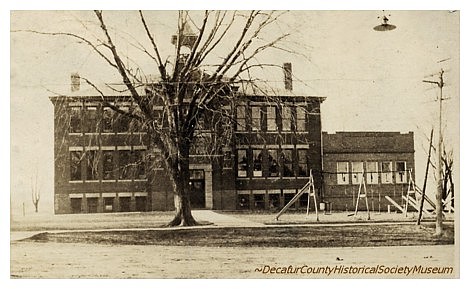 Photograph courtesy of Decatur County Historical Society Museum |
|||||||||||||||||||||||||||||||||||||||||||||||||||||||||||||||||||||||||||||||||||||||||||||||||||||
| The first school was taught in the winter of 1848-49. A frame schoolhouse was built in Garden Grove around the year 1853, with Reverend Carey, a Methodist minister, hired as the teacher. To the horror of the residents of Garden Grove, the new schoolhouse burned down on the first day of classes. A workman had been soldering some tin on the cupola and dropped a coal which ignited some shavings, catching the schoolhouse on fire. An octagon-shaped schoolhouse of brick was erected in 1856 with Professor Hastings hired as the first teacher. It was proclaimed that this schoolhouse was the best in Southern Iowa. Under the direction of R. A. Harness, formerly of Delaware County, New York, the octagon schoolhouse was called the Athens of Iowa. It achieved renown as a fine example of education. Later, the octagon building was razed and a frame building erected in 1873. The frame building was later replaced with a new schoolhouse. In 1915, Garden Grove School had 2 male and 9 female teachers with a total enrollment of 245 students. |
|||||||||||||||||||||||||||||||||||||||||||||||||||||||||||||||||||||||||||||||||||||||||||||||||||||
| Leon | |||||||||||||||||||||||||||||||||||||||||||||||||||||||||||||||||||||||||||||||||||||||||||||||||||||
| The first schoolhouse in Leon, erected in 1854, was a log building
located on Gospel Ridge and East Leon. H. V. Wainright was the first
teacher, succeeded by Sarah Patterson Bradshaw who taught for two terms.
[Some accounts state that Humphrey Fullerton was Leon's first teacher
and Joe C. Porter was the second teacher.] Leon's first scholars were Martha (Ellis) James, Mary (Ellis) Coffin, Luticia (Ellis) Wainwright, Samuel Ellis, William Tharp, Belle (Tharp) Walker, Mattie (Tharp) Jordan, Martha (Jordan) Ackins, Benjamin Jordan, James Shackelford, Lyman East, Julian East, Albert Tharp, and Uz Tharp. The log schoolhouse had become too small to accommodate the number of students, so classes were moved in the summer of 1855 to the lower floor of the courthouse, a large frame building built in 1851 where the Varga home would later be located. George Thomas Young was employed as the teacher. While school was in session in 1857, a tornado ripped through Leon. Mr. Young risked his own life and limb by carrying out smaller children while the courthouse was being torn to shreds and the upper story blown down. Neither Mr. Young nor any of the 80 students were injured. Miss Nellie Arnold held classes in a log cabin during the winter of 1856 and summer of 1857. A new schoolhouse was constructed in 1857 with Mr. L. M. Hastings teaching for the winter term. Teachers during this time were George Adams, succeeded by Samuel Sears, Carl Porter, Mr. Judd, Emily Higbee. At some point in time, a frame schoolhouse, known as Gospel Ridge was built in the east side of Leon. J. C. Porter was among the first teachers there. Sarah Patterson-Bashaw was the teacher for the 1858 summer term; J. C. Porter taught the winter term. Mrs. Higby-Warner taught the summer term of 1859; Carr Porter taught the winter term. Between the years of 1860 and 1864, there were more than one school in session at the same time. One room was not large enough to accommodate the students. Sarah Patterson-Bashaw held classes in a log cabin behind Mr. Orslin's shoe shop. Sam Sears held classes in the upper floor of the L. P. Sigler building; Mr. Strong held classes in the lower story. Leon's teachers between 1860 and 1864 included: George Adams, Mr. Wainright, Emily Higbee, Sarah Kirkpatrick, Professor Lewis teaching in a small building east of Brown's Hotel, Miss Sill Jones teaching in a frame building west of Teale & Wharton's store, Andrew Warner, and I. P. Martin teaching classes in the Methodist Episcopal Church. Around 1864, classes were held in the old Methodist Episcopal Church, which was then located on the lot where the Leon Carnegie Library now stands at the intersection of Highways 2 and 69. Those who taught between 1864 and 1868 include Professor Lewis, J. C. Porter, Sarah Kirkpatrick, C. S. Porter, Mr. Caldwell, Andrew Warner, and L. M. Hastings with Mrs. Hastings and Mrs. Lizzie Simmons-Vail as his assistants. L. P. Martin conducted classes in a building where Frank Clark's grocery store would later be located. |
|||||||||||||||||||||||||||||||||||||||||||||||||||||||||||||||||||||||||||||||||||||||||||||||||||||
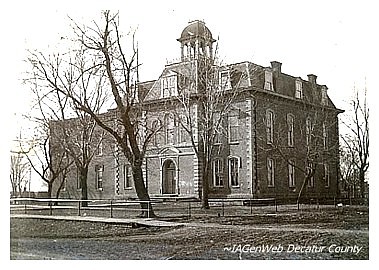 Photograph of Leon's School Courtesy of Decatur County Historical Society Museum Leon's First Brick Schoolhouse |
|||||||||||||||||||||||||||||||||||||||||||||||||||||||||||||||||||||||||||||||||||||||||||||||||||||
| The first schoolhouse in Leon was erected by John Kirkpatrick on the
site where the North school building would later stand [now the site of
Grand River Mutual Telephone office]. The first school building was made
of brick and contained four classrooms. At first there were home made
seats and desks, recitation seats and a long blackboard in the
classrooms. By the fall of 1864, only two of the rooms were completed.
Professor Hasting held classes in the south upper room; Sarah
Kirkpatrick taught class in the north room. When the building was
completed, the bell from the old courthouse placed on the new school. Mr. S. P. Hencomb was the principal for the 1865-66 school year. Sarah Kirkpatrick-Baldwin and Sarah Patterson-Badshaw were the teachers. Professor Abbott was the principal for the 1866-67 school year. Teachers were Gusta Smith, Emma Blair, Mrs. Reed, Linnie Arnold-Horner, Eliza Avery, Professor Newcomb, and Emma Dawson. Aaron Frazier initiated a 12-year course of study which included Latin and German. The school year was expanded to nine months, and the school became a graded* institution in the fall of 1867. There were four rooms and three grades in each room. Under Aaron Frazier, the first graduating exercises in Leon were held in 1871 with A. F. Woodruff, Matilda (Jordan) Critchfield, Samuel A. Gates, and T. W. Silvers receiving their diplomas. The class bought an organ for the school at a cost of $275. It also started the school library, purchased a globe, a dictionary, a microscope, electric machine and a history chart, raising the funds from exhibitions and festivals. Teachers hired for a term of ten weeks on January 2, 1872 were Emma Dawson, Hettie Rogers, and Mrs. Reed; and on March 22, 1872, Mrs. Reed. T. W. Silvers, and Emma Dawson. On August 16, 1872, Mr. W. S. Domer was the principal with Mrs. Reed, Ella Eaton, and Mollie Miles, teachers. Teachers hired for a term of twelve weeks, commencing on the first Monday in January of 1873 were Lucy Black, Mollie Miles, and Emma Dawson. W. S. Domer was re-elected principal on April 3, 1873 with Lucy Corbett, Emma Dawson, and Mollie Miles, teachers. A committee order on April 10, 1873, that a room in the basement of the Presbyterian Church be rented and used for Primary classrooms. Mrs. Hyatt was employed as the teacher. Aaron Frazier was elected as principal for the school terms of 1873 and 1874. Emma Mills Mollie Miles, and J. L. Harvey taught classes in 1873; Lucy Corbett, Emma Mills, J. F. Kirkpatrick, Mrs. Hyatt, Esther Sanger, Laura Dye, Leota Haywood, Josie Miles, and Mettie Pitman taught in 1874. The Babbott Writing Book was adopted as a textbook for the school. On December 31, 1874, it was determined that five more months be added to the school year with one week vacation. R. L. Parrish was elected principal for the 1875-76 school year. Laura Dye, T. J. Hastings, Esther Sanger, Josephine Kellogg, and Ellen Gammon taught in 1875; Kittie Stone, Josephine Kellogg, Belle Thompson, and Laura Dye taught in 1876. It was ordered on August 12, 1876 that the school year be held for nine months, commencing on September 4, 1876. The first term would be of seventeen weeks, the last term of nineteen weeks after a vacation of two weeks. |
|||||||||||||||||||||||||||||||||||||||||||||||||||||||||||||||||||||||||||||||||||||||||||||||||||||
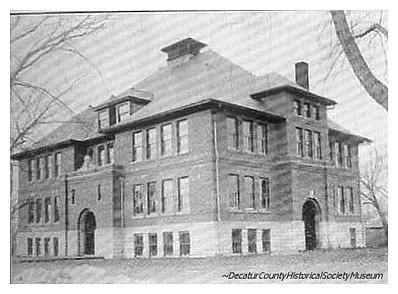 Photograph of Leon's School Courtesy of Decatur County Historical Society Museum Leon's Second Brick School House, 1876 - 1902 |
|||||||||||||||||||||||||||||||||||||||||||||||||||||||||||||||||||||||||||||||||||||||||||||||||||||
| Professor Frazier taught at the little brick schoolhouse until
1876 when a second brick building was erected on the site where the
school would be located until the 1990's. This second schoolhouse,
completed on September 13, 1877, consisted of eight rooms and cost
$11,000. The little brick schoolhouse was used as a janitor's residence
for several years. A new department, the Second Intermediate Department, was added on December 10, 1877. In 1878, the school year was expanded to 10 months. Mrs. C. M. Des Islets was the principal 1877-1881, with the following 1887-1881 teachers: Ella Gammon, Emma Wilson, Esther Sanger, T. J. Hastings, William Field, Allie Porter, W. H. Albaugh, Mrs. M. A. Critchfield, L. P. Martin, S. D. Calhoun, Stephen Varga, Miss Davidson, and Mrs. Reed. Miss Pollard was hired as the music teacher, providing instruction of two lessons of fifteen minutes to each department twice a week. Principals at the Leon School were: |
|||||||||||||||||||||||||||||||||||||||||||||||||||||||||||||||||||||||||||||||||||||||||||||||||||||
|
|||||||||||||||||||||||||||||||||||||||||||||||||||||||||||||||||||||||||||||||||||||||||||||||||||||
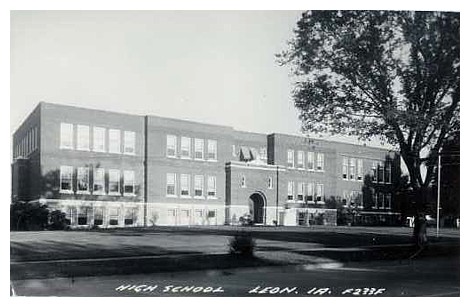 Photograph courtesy of Sharon R. Becker Leon's Third High School, built in 1903 |
|||||||||||||||||||||||||||||||||||||||||||||||||||||||||||||||||||||||||||||||||||||||||||||||||||||
| In 1903, the 1876 schoolhouse was torn down and a new one built in its place which was annexed to the 1895 building. In 1915, there were nineteen teachers and a student body of 610 pupils attending the north and the south schools. | |||||||||||||||||||||||||||||||||||||||||||||||||||||||||||||||||||||||||||||||||||||||||||||||||||||
 Photograph courtesy of Decatur County Historical Society Museum Leon School Teachers, 1900 L-R: Addie Crawford Chambers, Hallie Moore Biddison, Hattie Drake, Harriet Metier, Ophie Clark, May Caster, Mrs. Mattie Lindsey, Kate Ogden, Grace Morrell, Grace Wallace, Ollie Rock Gillham |
|||||||||||||||||||||||||||||||||||||||||||||||||||||||||||||||||||||||||||||||||||||||||||||||||||||
 Photograph courtesy of Decatur County Historical Society Museum Leon School Teachers, 1907 L-R: May Parish, May Caster, Grace Wallas, Ella Kemp |
|||||||||||||||||||||||||||||||||||||||||||||||||||||||||||||||||||||||||||||||||||||||||||||||||||||
 Photograph courtesy of Decatur County Historical Society Museum Leon Teachers, 1915 Lydia Epperly, Grace Beavers Cox, Olive Gwinn, Nellie Mullin, Helen Deck, Nita Cherry, Margaret Hurst, Frances Sears, Hollie Moore, Himena Hoffman, Adda Crawford Chambers, Professor Gass, Josie Conney, Vee Farquhar, Ella Grogan |
|||||||||||||||||||||||||||||||||||||||||||||||||||||||||||||||||||||||||||||||||||||||||||||||||||||
| Weldon | |||||||||||||||||||||||||||||||||||||||||||||||||||||||||||||||||||||||||||||||||||||||||||||||||||||
| With the arrival of the Humeston, Shenandoah Railroad in
1879, the town of Weldon was founded. Emma De Selm taught in the
subscription** school with classes held in the I.O.O.F. Hall. By the
following spring, students attended class in a country school located 1
mile south of town. Later, classes were held in the Christian Church. W. E. Morrow taught the first term in the Christian Church, followed by Dr. Mitchell for one term and Mr. Witmarsh for another term. In the fall of 1881, William Morren was hired to teach classes in the second floor of Weldon's new town hall. This school was set off as an independent school district on October 1, 1882. Members of the school board were George E. Mitchell, S. M. Prowell, and L. T. Greenlee. Dr. Enos Mitchell taught summer term classes in 1883, paid a salary of $25 per month. Many a time, Dr. Mitchell was obliged to leave the classroom in the charge of an older student so that he could attend to the needs of one of his patients. 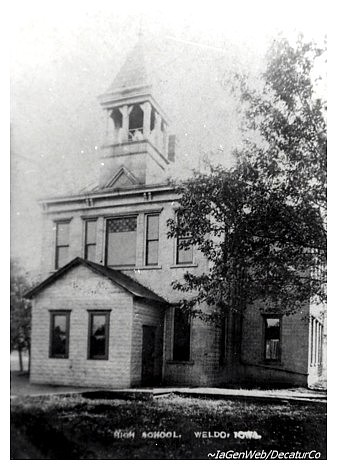 In
1883, a school building was constructed in the eastern part of Weldon.
J. H. Jamison taught the first term in the new church. Other teachers
were Ira Condit, Mr. Roy, Mr. Wingett, Mr. Cozad, Mr. Palmer, Mr.
Ratcliff, Mr. Latta, and Mr. Hill. In
1883, a school building was constructed in the eastern part of Weldon.
J. H. Jamison taught the first term in the new church. Other teachers
were Ira Condit, Mr. Roy, Mr. Wingett, Mr. Cozad, Mr. Palmer, Mr.
Ratcliff, Mr. Latta, and Mr. Hill.In the fall of 1884, Mrs. M. A. Critchfield assumed the teaching position at Weldon with an enrollment of approximately 70 students. The following year Miss Millie Grimes was hired to assist Mrs. Critchfield. With increasing enrollment, a new two-story schoolhouse was erected in 1885 at a cost of $2,000, which included the grounds, with Joseph Coffee as the contractor. Mrs. Critchfield was assisted with the primary grades by Miss Nora Brown. J. H. Jamison, who would later serve as a Senator, was the principal in 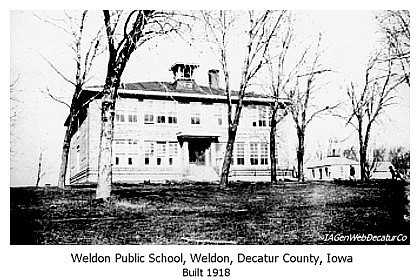 1886-1887.
I. S. Condit, later professor of mathematics at Iowa State Teacher's
College, was the principal in 1888, preceded by A. A. Roy who
initialized steps in the school becoming a graded institution, J. C.
Wingett, Charles Fisher, and J. W. Cozad who held Weldon's first
graduation exercises in the spring of 1893. Weldon's first graduating
class was Maitland Maxwell, Joe Lane, Frank Durnall, Jessie Marshall,
Anna Kline, and Ella Tallman. 1886-1887.
I. S. Condit, later professor of mathematics at Iowa State Teacher's
College, was the principal in 1888, preceded by A. A. Roy who
initialized steps in the school becoming a graded institution, J. C.
Wingett, Charles Fisher, and J. W. Cozad who held Weldon's first
graduation exercises in the spring of 1893. Weldon's first graduating
class was Maitland Maxwell, Joe Lane, Frank Durnall, Jessie Marshall,
Anna Kline, and Ella Tallman.Photographs courtesy of Decatur County Historical Society Museum Attendance at the Weldon school made it necessary to erect a new schoolhouse in 1895. During the construction of the new building, High School classes were held in the Opera House. As attendance grew, additions were erected to the school. In 1915, there was an enrollment of 130 pupils with five teachers and a music teacher. Those who served as principals include A. N. Smith, J. A. McIntosh, J. M. Howell, and H. J. O'Neil. In 1915, Weldon School had 1 male and 5 female teachers with a total enrollment of 132 students. |
|||||||||||||||||||||||||||||||||||||||||||||||||||||||||||||||||||||||||||||||||||||||||||||||||||||
| Grand River | |||||||||||||||||||||||||||||||||||||||||||||||||||||||||||||||||||||||||||||||||||||||||||||||||||||
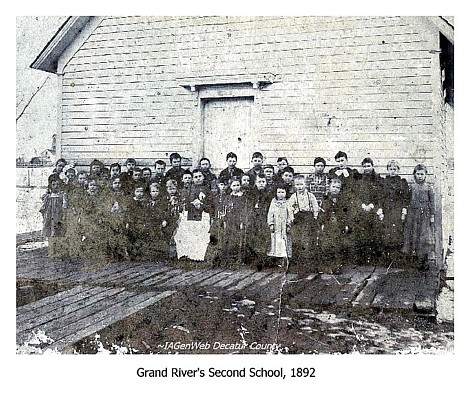 1892 |
|||||||||||||||||||||||||||||||||||||||||||||||||||||||||||||||||||||||||||||||||||||||||||||||||||||
| In 1874, sub-district No. 5 of Richland Township
was made into an independent district. A new schoolhouse was erected in
1876 at Grand River with Nora Gassett-Eiker, Ellen Gammon-Long, and
Hannah Hutchinson were the first to teach in the new schoolhouse. With attendance outgrowing the building, a larger schoolhouse 28 x 40 was erected a short distance from the first building. For a time, classes were held in both buildings. Charles Matsler, Bert Emerson, and V. R. McGinnis were among those who taught at Grand River. Later, both buildings were sold, one serving as a residence and the other as a church. John Waterman made the initial attempts to achieving a graded school status for the Grand River school in 1890. His course of study remained in effect with virtually no changes from 1890 to 1896. The first graduating class of Grand River, Frank Bone, Robert Snyder, John Burkhart, Nora Boyd, Nora Overholtzer, and Nellie Brennaman, received their diplomas in the spring of 1895. A new schoolhouse was erected in Grand River in 1897 with four rooms, a library, and a recitation room. Four teachers were hired to teach eleven grades. Principals included R. E. Porter, R. W. Boeger, J. L. Latta, H. L. Cosner, V. W. Webber, John Burkhart, and Charles H. Tedford. In 1915, Grand River School had 1 male and 3 female teachers with a total enrollment of 167 students. |
|||||||||||||||||||||||||||||||||||||||||||||||||||||||||||||||||||||||||||||||||||||||||||||||||||||
 |
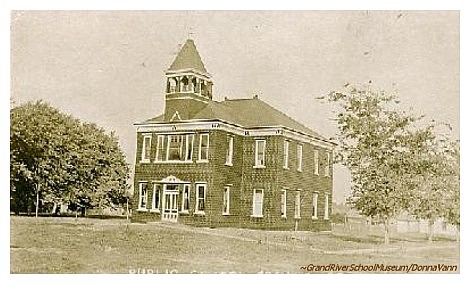 Photograph courtesy of Grand River School Museum and Donna Vann |
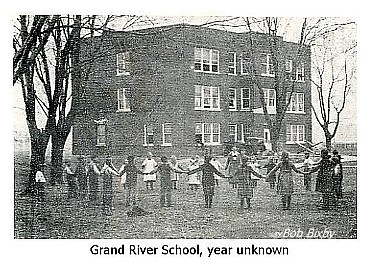 Photograph courtesy of Bob Bixby This school house was erected after 1915 |
|||||||||||||||||||||||||||||||||||||||||||||||||||||||||||||||||||||||||||||||||||||||||||||||||||
| Lamoni | |||||||||||||||||||||||||||||||||||||||||||||||||||||||||||||||||||||||||||||||||||||||||||||||||||||
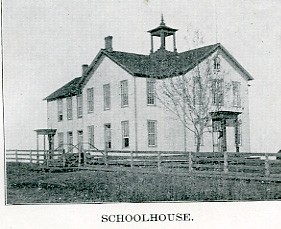 Lamoni's
pupils attended the school district of Fayette Township No. 1. Classes
were held in a small frame schoolhouse located east of town. Early
teachers included Earl D. Bailey, A. L. Ferguson, Inas Peck, Julia
Hoadley, and Miss Fuller. Lamoni's
pupils attended the school district of Fayette Township No. 1. Classes
were held in a small frame schoolhouse located east of town. Early
teachers included Earl D. Bailey, A. L. Ferguson, Inas Peck, Julia
Hoadley, and Miss Fuller.In 1882, the district rented a carpenter shop located in Lamoni's business section, providing an additional educational location. The main part of the old "East Side" building was erected in 1883, containing three classrooms. The first teacher in this schoolhouse was Professor A. A. Roy, teaching from 1883 to 1886. Professor Andrews taught for two terms, preceded by Professor D. F. Lambert who taught until 1889. Lamoni's first graduation exercises were held in the spring of 1888 with Frank Stoddard, Addie Smith, Cora Bailey, Martha Robinson, Frances Walker, and Mary Evans receiving their diplomas. Professor Gunsolly taught at the school until the fall of 1894 when he accepted a position at Graceland College [now Graceland University.] During this time, attendance had grown, requiring the erection of the north wing of the old East Side Schoolhouse. By 1894, a four-roomed brick building was built in the west part of town. Professor D. F. Lambert resumed charge of the school, retaining this position until 1897. |
|||||||||||||||||||||||||||||||||||||||||||||||||||||||||||||||||||||||||||||||||||||||||||||||||||||
 Photograph courtesy of Decatur County Historical Society Museum Lamoni Brick School, built 1913 |
|||||||||||||||||||||||||||||||||||||||||||||||||||||||||||||||||||||||||||||||||||||||||||||||||||||
| The Lamoni school board purchased the old lumberyard lot
and shed, quickly converted it into the Red Central schoolhouse in 1896.
In 1913, a new brick schoolhouse was built south of Herald Publishing
House at a cost of $50,000. Those who taught at Lamoni's school include Professors G. N. Briggs, Mr. Buffman who later taught at North Dakota University, Mr. Griffiths, Mr. Hannum, O. H. Hollen, Mr. Fisher, and Mr. Neveln. In November of 1914, the school building caught on fire, destroying the roof and interior. The exterior walls were not damaged in the fire. The town immediately went to work, rebuilding the school which served the community well. In 1915, Lamoni School had 2 male and 12 female teachers, four schoolhouses and a total enrollment of 466 students. |
|||||||||||||||||||||||||||||||||||||||||||||||||||||||||||||||||||||||||||||||||||||||||||||||||||||
| Pleasanton | |||||||||||||||||||||||||||||||||||||||||||||||||||||||||||||||||||||||||||||||||||||||||||||||||||||
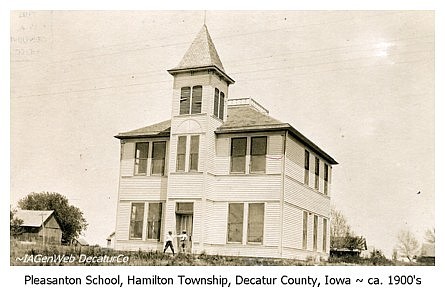
 Photograph courtesy of Decatur County Historical Society Museum |
|||||||||||||||||||||||||||||||||||||||||||||||||||||||||||||||||||||||||||||||||||||||||||||||||||||
| After a tornado blew down the schoolhouse in June of
1865 [which also unroofed 13 houses], a one-story brick schoolhouse was
built on the same site. After it was determined to be dangerous, it was
torn down in 1898 to make way for a new frame two-story schoolhouse.
Teachers at the new schoolhouse included Erven Spencer, Mrs. Vena
Edwards, Ralph Shelton, and Miss Silvia Vandel. In 1915, Pleasanton School had 3 female teachers and a total enrollment of 124 students. |
|||||||||||||||||||||||||||||||||||||||||||||||||||||||||||||||||||||||||||||||||||||||||||||||||||||
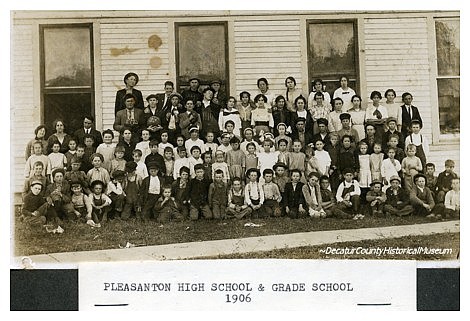 Photograph courtesy of Decatur County Historical Society Museum Pleasanton High School and Grade School, 1906 |
|||||||||||||||||||||||||||||||||||||||||||||||||||||||||||||||||||||||||||||||||||||||||||||||||||||
| Decatur City | |||||||||||||||||||||||||||||||||||||||||||||||||||||||||||||||||||||||||||||||||||||||||||||||||||||
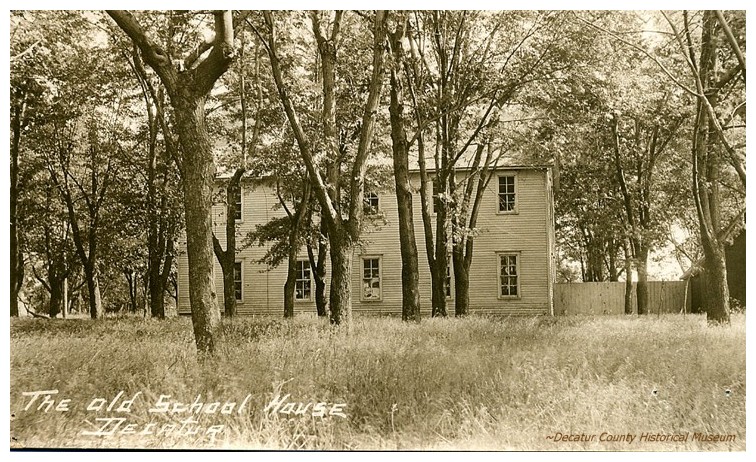 Photograph courtesy of Decatur County Historical Society Museum |
|||||||||||||||||||||||||||||||||||||||||||||||||||||||||||||||||||||||||||||||||||||||||||||||||||||
 During
the early days of Decatur City, there wasn't a schoolhouse. The children
attended classes in a store room, the Methodist Church, and a hotel. During
the early days of Decatur City, there wasn't a schoolhouse. The children
attended classes in a store room, the Methodist Church, and a hotel.The first schoolhouse was a log building. Mr. James was the teacher in 1855. John Finley, Jr. of Leon also taught at the school. Decatur City's school was established as a common school district at an early time. It was made into an independent school district in 1864 and a frame schoolhouse was built in the center of the park at a cost of $3,000. Ed Sampson of Van Wert was the school principal in 1871 and 1872. The schoolhouse burned in 1885, carrying on $1,000 worth of insurance. Another schoolhouse was built in 1885 at a cost of $3,200. The schoolhouse measured 30 x 60 feet and was divided into two rooms. Decatur City's teachers included Mrs. Ownby, Henry and Sarah Alden, I. N. W. Cooper, and Col. H. W. Peck during the 1880's. Those who served as school principals were Professors W. H. Kalkofen, D. W. Greenslate, Arthur Moore, J. W. Long, Ed Conwell, J. M. Howell, Erven Spencer, J. C. Cozad, and F. H. Riggle. In 1915, Decatur School had 1 male and 4 female teachers with a total enrollment of 118 students. |
|||||||||||||||||||||||||||||||||||||||||||||||||||||||||||||||||||||||||||||||||||||||||||||||||||||
| Davis City | |||||||||||||||||||||||||||||||||||||||||||||||||||||||||||||||||||||||||||||||||||||||||||||||||||||
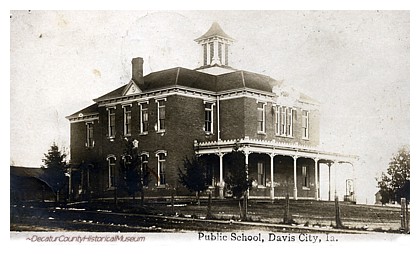 Photograph courtesy of Decatur County Historical Society Museum |
|||||||||||||||||||||||||||||||||||||||||||||||||||||||||||||||||||||||||||||||||||||||||||||||||||||
| The first classes in Davis City were held on S. W.
Davis' pasture located in the southwest portion of the town. Mrs. J. S.
Warner was the first teacher. Early teachers were Samuel Bowman in 1863,
N. C. Piercy in 1867, S. A. Gates in 1868. S. A. Gates returned to Davis
City and the classroom in 1874. He was paid $40.00 a month and had an
average of 72 students with 42 recitations daily. A three-roomed brick building was erected in 1875 at a cost of $2,200. William Poland was the principal from 1875 to 1880. Mrs. Lloyd Severe was the primary teacher. Teachers from 1875 to 1880 were A. M. Morgan, E. J. Hainer who was later a U.S. congressman, W. P. Davidson, and J. C. Hainer who later was an instructor at the State Agricultural College [present-day Iowa State University] in Ames. Other principals were J. M. Howell, J. W. Long and James Dutton. Photograph courtesy of Decatur County Historical Museum A new schoolhouse was erected in 1890. The first principal in the new school was Mr. Darrah. Professor J. M. Howell later taught at the school. In 1915, Davis City School had 2 teachers, one male and one female, with a total enrollment of 250 students. |
|||||||||||||||||||||||||||||||||||||||||||||||||||||||||||||||||||||||||||||||||||||||||||||||||||||
| Van Wert | |||||||||||||||||||||||||||||||||||||||||||||||||||||||||||||||||||||||||||||||||||||||||||||||||||||
 Photograph courtesy of Decatur County Historical Museum Van Wert's Third School House |
|||||||||||||||||||||||||||||||||||||||||||||||||||||||||||||||||||||||||||||||||||||||||||||||||||||
| Van Wert's first schoolhouse was built
approximately 1/4 of a mile north of the town, then known as Prairie
City, in 1858. It was a log building measuring about 16 x 20 feet, with
one door and about two or three windows. Puncheon slats provided seating
for eight to ten students. A board placed upon pegs which had been
driven into the wall served as a writing desk. Early Van Wert teachers
included Miss Powell, Lewis Holt, James Blair, and Newton Piercy. Mrs.
Bell Burns-Harvey held the first Christmas exercises held in the town.
During the time Mrs. Burns-Harvey taught school, Prairie City changed
its name to Van Wert. A frame one-roomed building measuring 22 x 28 feet was erected in 1871. It was equipped with desks, a much needed improvement over boards, pegs, and puncheon slats. 77 students were enrolled in school during the winter of 1887-88. The following year, Van Wert erected a high school building. Later, an addition was built to accommodate an increasing enrollment. Principals at Van Wert school include Mr. Rhodes, V. R. McGinnis, A. A. Roy, Mr. McVey, F. P. Reed, O. H. Hollen, Dr. Davis, and Miss Poiteaus Halstead in 1915. In 1915, Van Wert School had 1 male and 5 female teachers with a total enrollment of 117 students. |
|||||||||||||||||||||||||||||||||||||||||||||||||||||||||||||||||||||||||||||||||||||||||||||||||||||
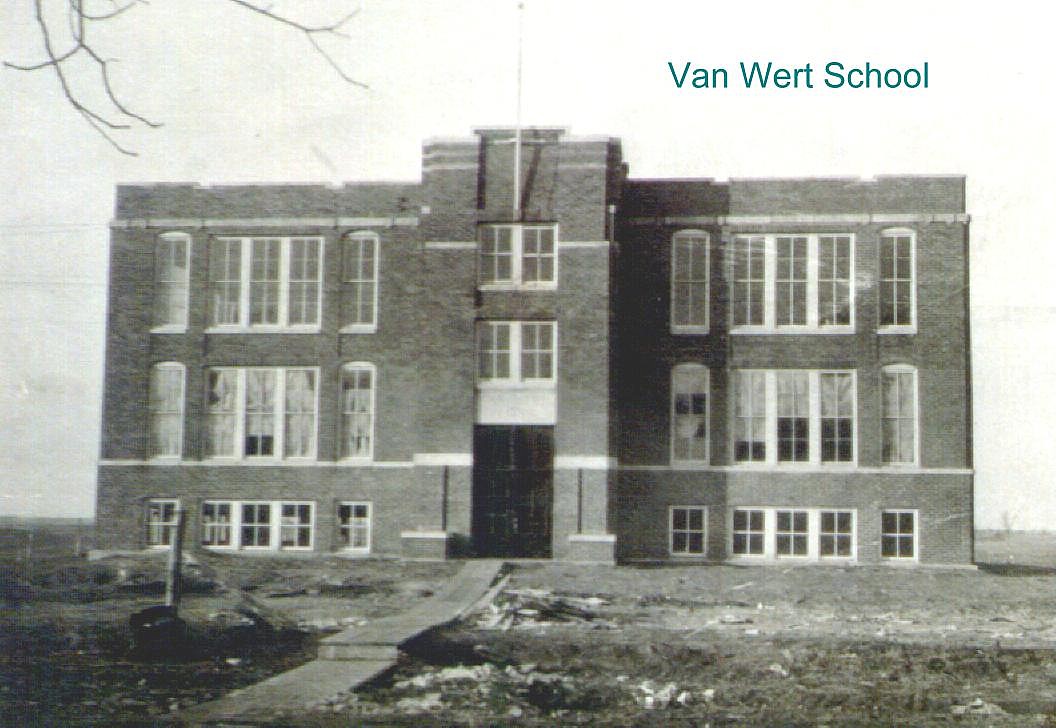 Photograph courtesy of Sherry Balow Van Wert High School, built 1918 |
|||||||||||||||||||||||||||||||||||||||||||||||||||||||||||||||||||||||||||||||||||||||||||||||||||||
| LeRoy | |||||||||||||||||||||||||||||||||||||||||||||||||||||||||||||||||||||||||||||||||||||||||||||||||||||
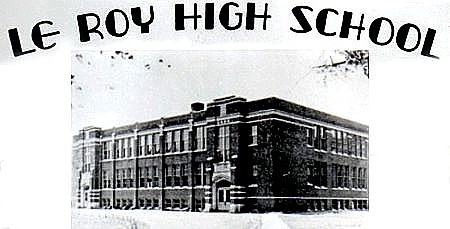 Photograph courtesy of IAGenWeb/DecaturCo Van Wert High School, built 1918 |
|||||||||||||||||||||||||||||||||||||||||||||||||||||||||||||||||||||||||||||||||||||||||||||||||||||
| Leroy's schoolhouse was built in the summer of 1904. In 1915, Leroy had 1 male and 2 female teachers with a total enrollment of 80 Students. |
|||||||||||||||||||||||||||||||||||||||||||||||||||||||||||||||||||||||||||||||||||||||||||||||||||||
| SOURCES: Howell, Prof. J. M. and Smith, Heman C. History of Decatur County and Its People. Vol. 1. S.J. Clarke Publishing Co. Chicago. 1915. Leon Reporter, Leon, Iowa. Thursday, July 14, 1898 Transcriptions and compilation by Sharon R. Becker, January 2014 |
|||||||||||||||||||||||||||||||||||||||||||||||||||||||||||||||||||||||||||||||||||||||||||||||||||||
| School Directory *** Decatur County IAGenWeb | |||||||||||||||||||||||||||||||||||||||||||||||||||||||||||||||||||||||||||||||||||||||||||||||||||||